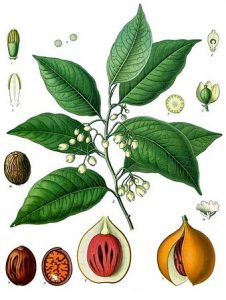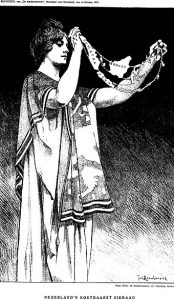Colonial Era
Beginning in the 16th century, successive waves of Europeans—the Portuguese, Spanish, Dutch and English—sought to dominate the spice trade at its sources in India and the ‘Spice Islands’ (Maluku) of Indonesia. This meant finding a way to Asia to cut out Muslim merchants who, with their Venetian outlet in the Mediterranean, monopolised spice imports to Europe. Astronomically priced at the time, spices were highly coveted not only to preserve and make poorly preserved meat palatable, but also as medicines and magic potions.
The arrival of Europeans in South East Asia is often regarded as the watershed moment in its history. Other scholars consider this view untenable, arguing that European influence during the times of the early arrivals of the 16th and 17th centuries was limited in both area and depth. This is in part due to Europe not being the most advanced or dynamic area of the world in the early 15th century. Rather, the major expansionist force of this time was Islam; in 1453, for example, the Ottoman Turks conquered Constantinople, while Islam continued to spread through Indonesia and the Philippines. European influence, particularly that of the Dutch, would not have its greatest impact on Indonesia until the 18th and 19th centuries.

Dutch settlement in the East Indies. Batavia (now Jakarta), Java, c. 1665 CE.
The Portugese
New found Portuguese expertise in navigation, shipbuilding and weaponry allowed them to make daring expeditions of exploration and expansion. Starting with the first exploratory expeditions sent from newly conquered Malacca in 1512, the Portuguese were the first Europeans to arrive in Indonesia, and sought to dominate the sources of valuable spices and to extend the Catholic Church’s missionary efforts. The Portuguese turned east to Maluku and through both military conquest and alliance with local rulers, they established trading posts, forts, and missions on the islands of Ternate, Ambon, and Solor among others. The height of Portuguese missionary activities, however, came in the latter half of the 16th century. Ultimately, the Portuguese presence in Indonesia was reduced to Solor, Flores and Timor in modern-day Nusa Tenggara, following defeat at the hands of indigenous Ternateans and the Dutch in Maluku, and a general failure to maintain control of trade in the region. In comparison with the original Portuguese ambition to dominate Asian trade, their influence on Indonesian culture was small: the romantic keroncong guitar ballads; a number of Indonesian words which reflect Portuguese’s role as the lingua franca of the archipelago alongside Malay; and many family names in eastern Indonesia such as da Costa, Dias, de Fretes, Gonsalves, etc. The most significant impacts of the Portuguese arrival were the disruption and disorganisation of the trade network mostly as a result of their conquest of Malacca, and the first significant plantings of Christianity in Indonesia. There have continued to be Christian communities in eastern Indonesia through to the present, which has contributed to a sense of shared interest with Europeans, particularly among the Ambonese.

The nutmeg plant is native to Indonesia’s Banda Islands. Once one of the world’s most valuable commodities, it drew the first European colonial powers to Indonesia.
Dutch East-India Company
In 1602, the Dutch parliament awarded the VOC a monopoly on trade and colonial activities in the region at a time before the company controlled any territory in Java. In 1619, the VOC conquered the West Javan city of Jayakarta, where they founded the city of Batavia (present-day Jakarta). The VOC became deeply involved in the internal politics of Java in this period, and fought in a number of wars involving the leaders of Mataram and Banten.
The Dutch followed the Portuguese aspirations, courage, brutality, and strategies but brought better organisation, weapons, ships, and superior financial backing. Although they failed to gain complete control of the Indonesian spice trade, they had much more success than the previous Portuguese efforts. They exploited the factionalisation of the small kingdoms in Java that had replaced Majapahit, establishing a permanent foothold in Java, from which grew a land-based colonial empire which became one of the richest colonial possessions on earth.
By the mid-17th century, Batavia, the headquarter of VOC in Asia, had become an important trade centre in the region. It had repelled attacks from the Javanese Mataram kingdom. In 1641, the Dutch captured Malacca from the Portuguese, thus weakened Portuguese position in Asia. The Dutch defeated the Sulawesi city of Makassar in 1667 thus bringing its trade under VOC control. Sumatran ports were also brought under VOC control and the last of the Portuguese were expelled in 1660. In return for monopoly control over the pepper trade and the expulsion of the English, the Dutch helped the son of the ruler of Banten overthrow his father in 1680. By the 18th century, the VOC has established themselves firmly in Indonesian archipelago, controlling inter-island trade as part of their Asian business which includes India, Ceylon, Formosa, and Japan. VOC has established their important bases in some ports in Java, Maluku, and parts of Sulawesi, Sumatra, and Malay Peninsula.

An early 18th-century Dutch map from a time when only the north coastal ports of Java were well known to the Dutch.
French and Britsh Interlude
After the fall of the Netherlands to the First French Empire and the dissolution of the Dutch East India Company in 1800, there were profound changes in the European colonial administration of the East Indies. The Company’s assets in East Indies were nationalised as the Dutch colony, the Dutch East Indies. Meanwhile, Europe was devastated by the Napoleonic Wars. In the Netherlands, Napoleon Bonaparte in 1806 oversaw the dissolution of the Batavian Republic, which was replaced by the Kingdom of Holland, a French puppet kingdom ruled by Napoleon’s third brother Louis Bonaparte (Lodewijk Napoleon). The East Indies were treated as a proxy French colony, administrated through a Dutch intermediary.
In 1806, King Lodewijk of the Netherlands sent one of his generals, Herman Willem Daendels, to serve as governor-general of the East Indies, based in Java. Daendels was sent to strengthen Javanese defences against a predicted British invasion. Since 1685, the British had had a presence in Bencoolen on the western coast of Sumatra, as well as several posts north of the Malaccan straits. Daendels was responsible for the construction of the Great Post Road (Indonesian: Jalan Raya Pos) across northern Java from Anjer to Panaroecan. The thousand-kilometre road was meant as to ease logistics across Java and was completed in only one year, during which thousands of Javanese forced labourers died. Raffles launched several military expeditions against local Javanese princes; such as the assault on Yogyakarta kraton on 21 June 1812, and the military expedition against Sultan Mahmud Badaruddin II of Palembang, along with giving orders to seize the nearby Bangka Island. During his administration, numbers of ancient monuments in Java were rediscovered, excavated and systematically catalogued for the first time, the most important one is the rediscovery of Borobudur Buddhist temple in Central Java. Raffles was an enthusiast of the island’s history, as he wrote the book History of Java published later in 1817. In 1815, the island of Java was returned to control of the Netherlands following the end of Napoleonic Wars, under the terms of the Anglo-Dutch Treaty of 1814.

The Java Great Post Road, commissioned by Daendels.
Dutch State Rule
After the VOC was dissolved in 1800 following bankruptcy, and after a short British rule under Thomas Stamford Raffles, the Dutch state took over the VOC possessions in 1816. A Javanese uprising was crushed in the Java War of 1825–1830. After 1830, a system of forced cultivations and indentured labour was introduced on Java, the Cultivation System (in Dutch: cultuurstelsel). This system brought the Dutch and their Indonesian allies enormous wealth. The cultivation system tied peasants to their land, forcing them to work in government-owned plantations for 60 days of the year. The system was abolished in a more liberal period after 1870. In 1901, the Dutch adopted what they called the Ethical Policy, which included somewhat increased investment in indigenous education, and modest political reforms.
Dutch imperial painting depicting the Dutch East Indies as “our most precious gem”. (1916).
Dutch imperial painting depicting the Dutch East Indies as “our most precious gem”. (1916).
The Dutch colonials formed a privileged upper social class of soldiers, administrators, managers, teachers, and pioneers. They lived together with the “natives”, but at the top of a rigid social and racial caste system. The Dutch East Indies had two legal classes of citizens; European and indigenous. A third class, Foreign Easterners, was added in 1920.
Upgrading the infrastructure of ports and roads was a high priority for the Dutch, with the goal of modernising the economy, pumping wages into local areas, facilitating commerce, and speeding up military movements. By 1950, Dutch engineers had built and upgraded a road network with 12,000 km of asphalted surface, 41,000 km of metalled road area and 16,000 km of gravel surfaces. In addition the Dutch built 7,500 kilometres (4,700 mi) of railways, bridges, irrigation systems covering 1.4 million hectares (5,400 sq mi) of rice fields, several harbours, and 140 public drinking water systems. These Dutch constructed public works became the economic base of the colonial state; after independence, they became the basis of the Indonesian infrastructure.
For most of the colonial period, Dutch control over its territories in the Indonesian archipelago was tenuous. In some cases, Dutch police and military actions in parts of Indonesia were quite cruel. Recent discussions, for example, of Dutch cruelty in Aceh have encouraged renewed research on these aspects of Dutch rule. It was only in the early 20th century, three centuries after the first Dutch trading post, that the full extent of the colonial territory was established and direct colonial rule exerted across what would become the boundaries of the modern Indonesian state. Portuguese Timor, now East Timor, remained under Portuguese rule until 1975 when it was invaded by Indonesia. The Indonesian government declared the territory an Indonesian province but relinquished it in 1999.

Batavian (Jakarta) tea factory in the 1860s.

Dutch imperial painting depicting the Dutch East Indies as “our most precious gem”. (1916).
